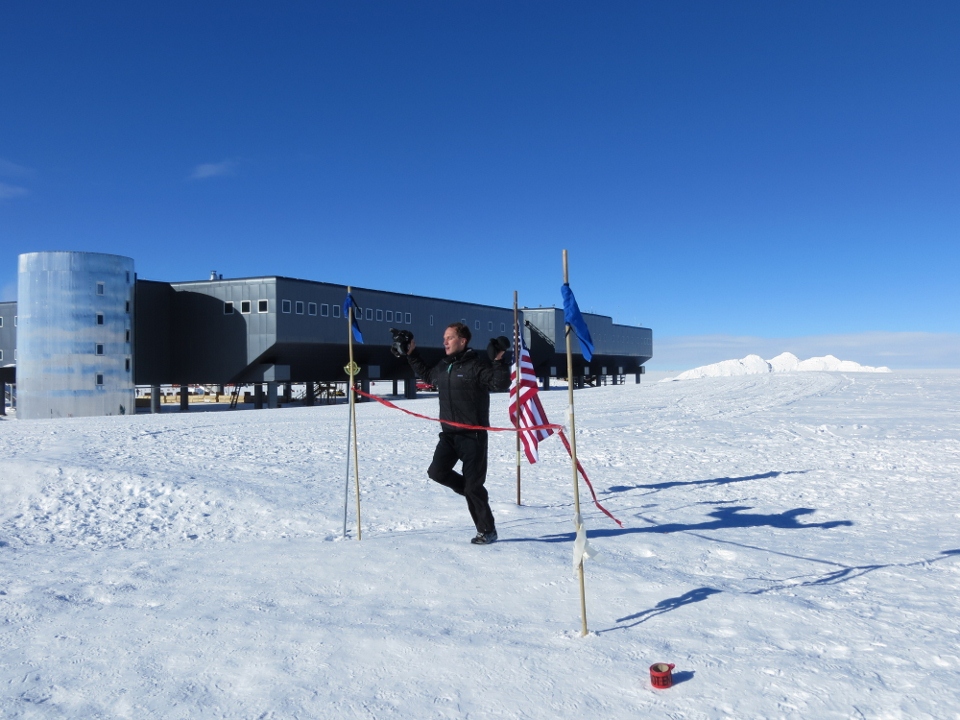South Pole Marathon 2012
“Tell your boy that I’ve got a six pack on him and he’d better win.”
Eric eyed me through the dish pit window as I scraped egg remains from the breakfast plates in the South Pole galley. The marathon was coming up and bets were flying as to who would finish first. Eric and other local gamblers had a special interest in the outcome of the race as they calculated the odds and bet money and six-packs of beer on their favored contestants.
My husband, Keith, 34, was a top contender. He had attended college on a cross-country team scholarship earned from his record-breaking high school running career. His previous South Pole Marathon experience and Leadville Trail 100 history put him in good standing now. With characteristic self-discipline, he had been running every day and training outside for long runs on Sundays. Shane had also been training daily with his eyes on the win. His solid ultra-running history made him another favorite among the betters. Thirty years old, wearing a perpetual expression of determination, he trained frequently at high altitudes near his home in Colorado, had completed several 50-mile ultras, and had also made a good attempt on the Leadville Trail 100 two years previously. During his second week at the South Pole, Shane had completed a marathon on the treadmill in the Station’s gym and felt optimistic about his chances of winning the race. Alex, 23, tall and lean with a classic college track team captain facade, had won the annual 1.75-mile Race Around The World on Christmas Eve, but he was an inexperienced distance runner, having only completed one other marathon in his life. He was fast, but in this harsh Antarctic environment, I wasn’t sure he would have the maturity to pace himself for more than 26 miles. Sarah, 27, the marathon organizer, was the most serious runner of the lot. With the Wasatch Front 100-Mile Endurance Run, two previous South Pole Marathons, and several other ultra-marathons in her portfolio of experience, she was a strong competitor with several enthusiastic supporters who hoped a woman would win the race on the inhospitable course at 90° South. Ryan, Tom, and Joshua signed up, too, but people knew little about their running experience. Seven runners also signed up for the half marathon.
“We’re going to have to change the route of the marathon,” Sarah announced the night before the race to the small assembly of runners and volunteers. In the first two annual marathons, the runners had used the skiway, but this year flights were expected on New Year’s Eve and now this wouldn’t be an option.
“We’re going to be running to the ARA drill site,” Sarah continued, pulling out a hand-drawn map and pointing to the landmarks as she spoke. “Any volunteers traveling to ARA need to take a survival bag with them. Start and finish will be at the geographic South Pole. There will be an aid station at ARA and one at DA. It’s going to be a beautiful new route. I’m so excited!” Sarah almost panted with enthusiasm.
DA, or Destination Alpha, is the main entrance into the elevated South Pole Station. The distance between DA and ARA would be 3.3 miles, with a few tenths of a mile added on for the first and last laps out to the Pole. The full marathoners would complete 4 laps. I signed up to volunteer for the whole race, beginning at DA, moving on to ARA, and ending at the Pole to record the finishing times.
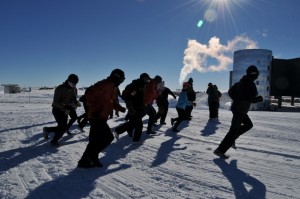
On the last day of 2012 the galley screen announced the temperature: -16°F, with a wind chill of -29°F, and a physiological altitude of 10,400 feet above sea level. Runners lined up at the Pole as I handed out stopwatches to volunteers. “Hit the start button on ‘go,'” I instructed. Then to the giddy runners: “Are you ready?” They nodded enthusiastically.
“On your mark, get set, GO!” I shouted, and the stopwatches began counting the seconds as the runners took off. With over an hour to go before the first marathoners would be arriving at DA, another volunteer and I began setting up the aid station while Sean, a third volunteer, hopped on a snowmobile and headed out to ARA.
“The first runner is coming back!” said one observer as he peered through his camera’s zoom lens out the second story window of the station. I looked at the stopwatch. Fifty minutes? Wow, this runner is booking it, I thought.
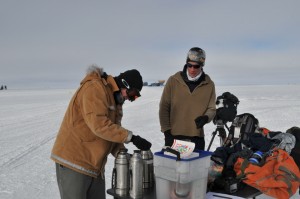
We hurried to move the last of the supplies out to the aid station and waited for this swift runner to come in. At exactly 1:00:43, Alex flowed to the aid station and accepted a cup of hot apple cider from us. He looked as though he’d been trotting down the hallway in the station. “Thanks a lot, guys!” he said, and streamed away for lap two, his long legs moving in fluid strides.
“That kid’s going way too fast,” I said, once he was out of earshot. “He’ll hit the wall before the race is over. There’s no way he can sustain that kind of pace–not here. By lap three or four he’ll be walking.”
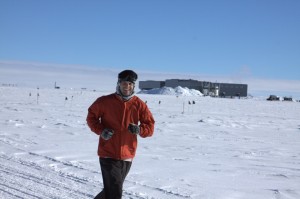
Five minutes later, Shane jogged up to the station in strong form, and took a glass of water.
“How are you feeling, Shane?” I asked.
“I’m feeling great!” he smiled, radiating energy and confidence. “Take it easy!” And off he ran.
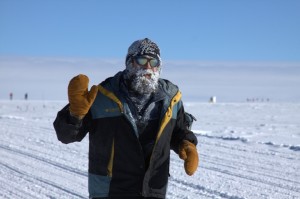
At one hour and 8 minutes, Joshua chugged up to the aid station with his great beard covered in large icicles, and drank some hot cider. He had a solid build; a soft-spoken iron worker who always dressed in thick black Carhartt overalls. He sometimes volunteered in the dish pit after breakfast and until I saw his name on the marathon list I never suspected he was a runner. Here he was in third place. “Good job, Joshua!” I shouted after him as he lumbered off for round two.
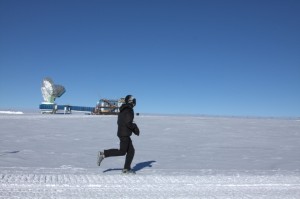
I looked up and recognized Keith’s machine stride as he approached, wearing a full face mask. He reached the station at 1:11:50. Keith drank some hot broth and ate a cookie, looking quite fresh. He wasn’t even breathing hard. A minute later he was back on the course. I knew he’d be overtaking some of the other runners soon.
Ryan arrived one hour and 15 minutes into the race and was joined two minutes later by Sarah. They laughed happily while taking in their hot drinks, thanked us, and took off again. Tom, the last of the full marathoners, arrived an hour and 34 minutes into the race, a little out of breath. He downed his drink and kept on going.
Sean, volunteering at ARA, radioed me at the 2 hour mark to let me know he was coming back with the snowmobile. Mario had signed up to volunteer with me and together we took the snowmobile out to the other end of the race course. I sat behind Mario on the snow machine, keeping my head low against the frigid Antarctic wind. As we pulled away from the DA aid station we saw Alex approaching. Just two hours into the race, he was near the end of lap two. “He’s keeping an incredible pace,” I shouted to Mario over the roar of the snowmobile’s motor and the rushing wind.
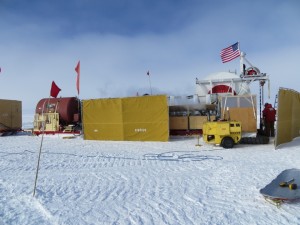
At ARA, the Askaryan Radio Array, holes are being drilled 210 meters into the ice and receiver antennas are being deployed to detect neutrinos. Once complete, the array will measure 100 square kilometers. The scientists at ARA welcomed us enthusiastically, smiling and joking with the volunteers and runners in their warming hut. ARA workers were drilling their last hole in a successful season and a sense of celebration buzzed in the air. Playing a part in the South Pole Marathon added to their cheer.
The generator-powered ARA warming hut came complete with a furnace, microwave, coffee maker, table and chairs. Sean had arranged the labeled runner’s cups and the snacks on the table. I set out to make some ramen noodles for the runners, then pulled out a box lunch of my own to eat while I waited. Two hours and 37 minutes into the race, Alex popped in, still ahead, on pace, and looking fresh.
“You’re impressing me, Alex,” I said. “Your pace is very steady and you’re over half way done!”
Alex flashed a big smile, thanked me for volunteering, and trotted off again.
After awhile a snowmobile pulled up to the warming hut and Eric walked in with a couple of his gambling buddies to check on the progress of the race.
Predictably, Shane came in next. “How’s it going?” I asked him.
His forehead wrinkled as he looked at me with his intense face. “I had to go inside the station and have my face looked at after Lap 2,” he said. “I have a bit of frostnip on my nose. The soft snow is tearing up my stabilizer muscle in my leg, too. If my stabilizer muscle goes I’m going to have to walk the rest of the way. I still feel pretty good, though; I’m still strong.”
“And you’re still in second place,” I said. “You’re doing great!”
“Thanks,” he replied. “This is a lot harder than I thought it would be.”
I handed Shane a bowl of ramen noodles, poured him a drink, and offered him a fresh pair of hand warmers. Eric seemed impressed with the care the runners were getting at the aid station and nodded approvingly. The gamblers wished Shane well.
“Thanks for coming out to support me, guys!” Shane said. After finishing his food and drink, he was off on the long jog back to DA. Eric and his buddies left, too.
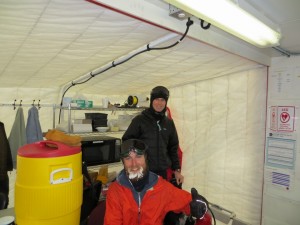
The winds picked up and clouds obscured the sun, bringing the wind chill down to near -40°F. Keith and Ryan passed Joshua and arrived at ARA in third and fourth place. Joshua had hit the wall and slowed down.
At the four-hour mark, the station physician, Dr. Sean, arrived to take over the ARA aid station. Alex was back, too, still strong. “Damn, Alex. You’re ripping it up! You’re on track to finish in under five hours!”
Mario and I took care of Alex and then hopped on the snowmobile back to DA. As we passed Joshua we slowed down to see how he was doing. “I’m ok,” he said, and waved us on. He had slowed to a walk but I saw determination in his stride. He was going to finish. Mario dropped me off at the DA aid station and I got a quick update from the other volunteers. Shane’s nose was now dangerously frost-nipped and he was forced to drop the race at the end of Lap 3. Tom was too tired to continue and had decided to finish at the half-marathon point. The sun had burned away the clouds again and I squinted off into the distance to see if any runners were in sight.
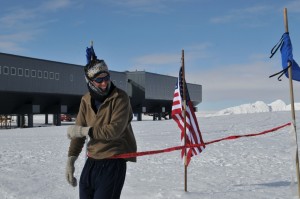
I knew Alex would be coming in soon and made my way toward the finish line at the Pole, stopwatch and time sheet in hand. Soon he appeared over the snowy horizon, still making fast, fluid strides toward the southernmost point of the earth. We cheered him over the finish line at 4 hours, 48 minutes, and 9 seconds. Alex had turned me into a believer; he definitely knows how to run.
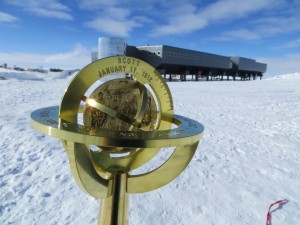
While we waited for the next runners to arrive, I toured the South Pole Visitor’s Center, a building designed for the tourists who visit our point on the planet throughout the summer months. I snapped pictures of the ceremonial Pole and the geographic marker which was up for its final day. Tomorrow there would be an unveiling of a new geographic Pole marker in its new location, about 10 meters away, to compensate for the shifting of the polar ice cap.
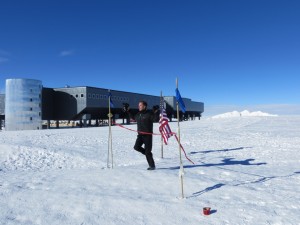
We watched the horizon for our runners as the 5-hour mark came and went and the 6-hour mark approached. Finally, I saw Keith approaching the Ice Cube Lab with his signature mechanical gait, and I returned to the Pole to see him in at 5 hours, 50 minutes and 11 seconds.
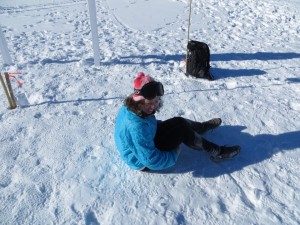
“That was actually 28.2 miles,” Keith said, looking at his GPS watch. He had come in second and beat his previous South Pole Marathon time by 26 minutes on a longer and more challenging course. He still looked ready to stay up and dance until midnight.
Sarah raced into 3rd place with a time of 5:55:44. “I didn’t make it easy to beat your time,” she laughed as she reached Keith. “That was a tough course. I think I’m actually going to be sore tomorrow.” She sat down on the icy ground to stretch and massage her legs.
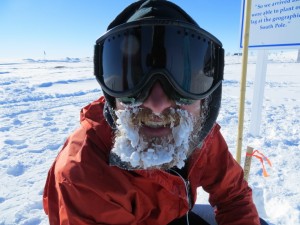
Ryan, beard crusted in ice, jogged through the finish line at 6:01:53 with a big smile. The runners went in for warm clothes and then came back out. Together, we all waited to cheer Joshua across the finish. “He’s not going to give up,” Sarah said. “He is going to make it across that line.” And sure enough, soon we saw him over the snow, steamrolling toward us with his white icicle beard. “Come on, Joshua!” we cheered, and at the extra encouragement he broke into a jog, crossing the finish line in 6 hours and 29 minutes.
The runners assembled at the South Pole sign for a photo before we all returned to the warm station, chatting about the New Year’s Eve dance party that evening.
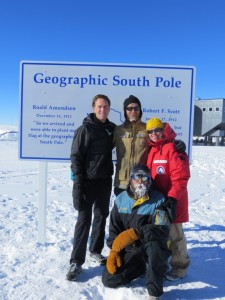
“I lost my six pack of beer,” Eric told Keith as we walked back to our berth. “But you’re a stud, and I respect you for that.”
“Thanks,” Keith said. “My wife thinks so, too.”
Enter your name and email to receive my newsletter and stay up to date!
We hate spam as much as you. Your email is safe with us.

